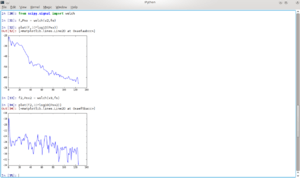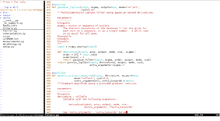SciPy
SciPy (pronounced /ˈsaɪpaɪ'/ "Sigh Pie"[3]) is a free and open-source Python library used for scientific computing and technical computing.
 PSD of ECG using SciPy | |
| Original author(s) | Travis Oliphant, Pearu Peterson, Eric Jones |
|---|---|
| Developer(s) | Community library project |
| Initial release | Around 2001 |
| Stable release | 1.4.1
/ 19 December 2019[1] |
| Preview release | 1.5.0rc2
/ 14 June 2020[1] |
| Repository | |
| Written in | Python, Fortran, C, C++[2] |
| Operating system | Cross-platform |
| Type | Technical computing |
| License | BSD-new license |
| Website | scipy |
SciPy contains modules for optimization, linear algebra, integration, interpolation, special functions, FFT, signal and image processing, ODE solvers and other tasks common in science and engineering.
SciPy builds on the NumPy array object and is part of the NumPy stack which includes tools like Matplotlib, pandas and SymPy, and an expanding set of scientific computing libraries. This NumPy stack has similar users to other applications such as MATLAB, GNU Octave, and Scilab. The NumPy stack is also sometimes referred to as the SciPy stack.[4]
SciPy is also a family of conferences for users and developers of these tools: SciPy (in the United States), EuroSciPy (in Europe) and SciPy.in (in India).[5] Enthought originated the SciPy conference in the United States and continues to sponsor many of the international conferences as well as host the SciPy website.
The SciPy library is currently distributed under the BSD license, and its development is sponsored and supported by an open community of developers. It is also supported by NumFOCUS, a community foundation for supporting reproducible and accessible science.
Components
The SciPy package of key algorithms and functions core to Python's scientific computing capabilities. Available sub-packages include:
- constants: physical constants and conversion factors
- cluster: hierarchical clustering, vector quantization, K-means
- fft: Discrete Fourier Transform algorithms
- fftpack: Legacy interface for Discrete Fourier Transforms
- integrate: numerical integration routines
- interpolate: interpolation tools
- io: data input and output
- lib: Python wrappers to external libraries
- linalg: linear algebra routines
- misc: miscellaneous utilities (e.g. image reading/writing)
- ndimage: various functions for multi-dimensional image processing
- optimize: optimization algorithms including linear programming
- signal: signal processing tools
- sparse: sparse matrix and related algorithms
- spatial: KD-trees, nearest neighbors, distance functions
- special: special functions
- stats: statistical functions
- weave: tool for writing C/C++ code as Python multiline strings

Data structures
The basic data structure used by SciPy is a multidimensional array provided by the NumPy module. NumPy provides some functions for linear algebra, Fourier transforms, and random number generation, but not with the generality of the equivalent functions in SciPy. NumPy can also be used as an efficient multidimensional container of data with arbitrary datatypes. This allows NumPy to seamlessly and speedily integrate with a wide variety of databases. Older versions of SciPy used Numeric as an array type, which is now deprecated in favor of the newer NumPy array code.[6]
History
In the 1990s, Python was extended to include an array type for numerical computing called Numeric (This package was eventually replaced by Travis Oliphant who wrote NumPy in 2006 as a blending of Numeric and Numarray which had been started in 2001). As of 2000, there was a growing number of extension modules and increasing interest in creating a complete environment for scientific and technical computing. In 2001, Travis Oliphant, Eric Jones, and Pearu Peterson merged code they had written and called the resulting package SciPy. The newly created package provided a standard collection of common numerical operations on top of the Numeric array data structure. Shortly thereafter, Fernando Pérez released IPython, an enhanced interactive shell widely used in the technical computing community, and John Hunter released the first version of Matplotlib, the 2D plotting library for technical computing. Since then the SciPy environment has continued to grow with more packages and tools for technical computing.[7][8][9]
See also
- Comparison of numerical analysis software
- List of numerical analysis software
- Comparison of statistical packages
- SageMath
Notes
- "Releases – scipy/scipy". Retrieved 31 May 2020 – via GitHub.
- SciPy Team. "How can SciPy be fast if it is written in an interpreted language like Python?". Retrieved 2013-12-23.
- https://scipy.org/ "SciPy (pronounced "Sigh Pie")"
- "Scientific Computing Tools for Python". SciPy.org.
- "SciPy Conferences".
- "NumPy Homepage".
- "History of SciPy".
- "Guide to NumPy" (PDF).
- "Python for Scientists and Engineers".
Further reading
- Nunez-Iglesias, Juan; van der Walt, Stéfan; Dashnow, Harriet (2017). Elegant SciPy: The Art of Scientific Python. O'Reilly. ISBN 978-1-4919-2287-3.